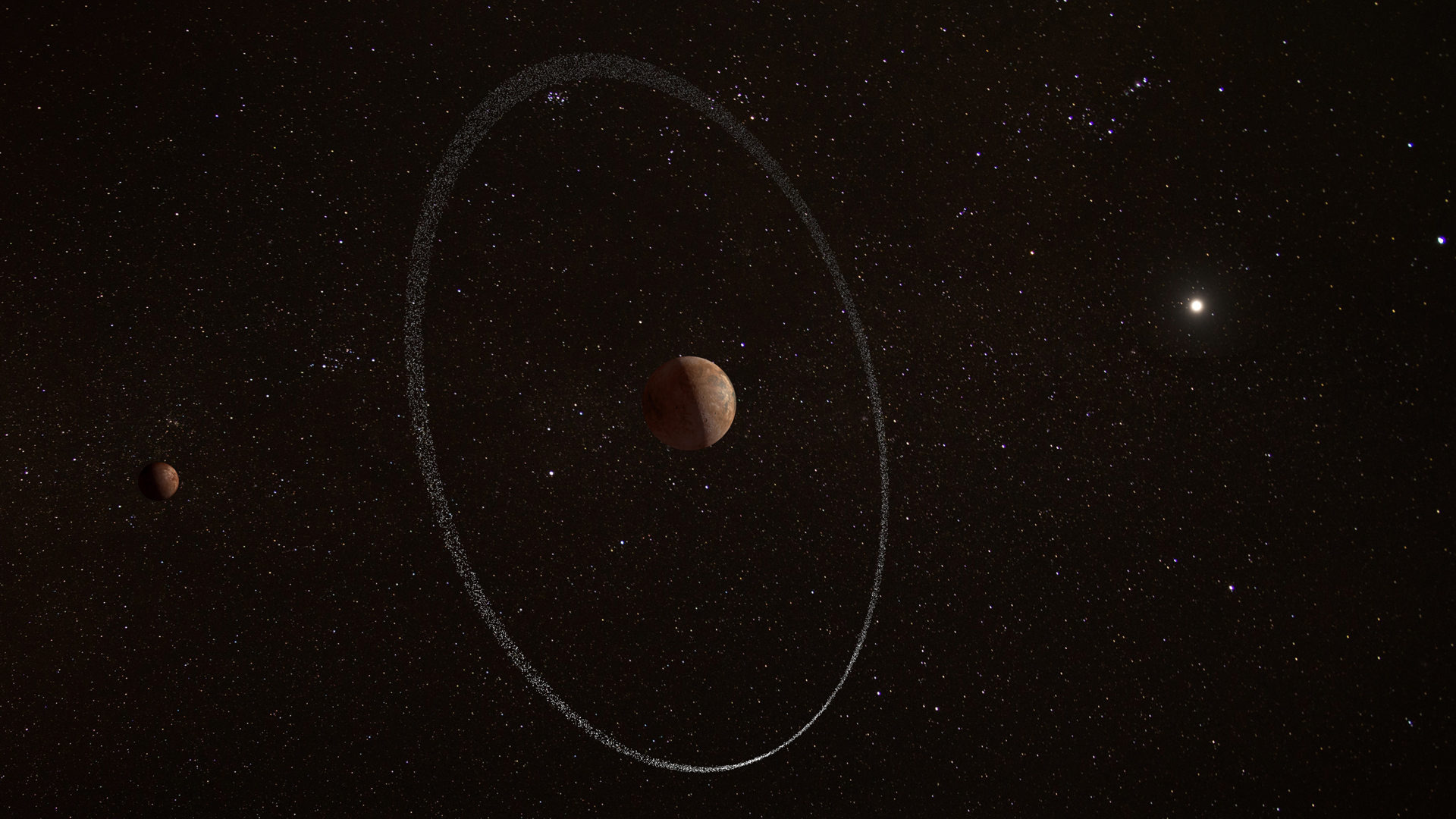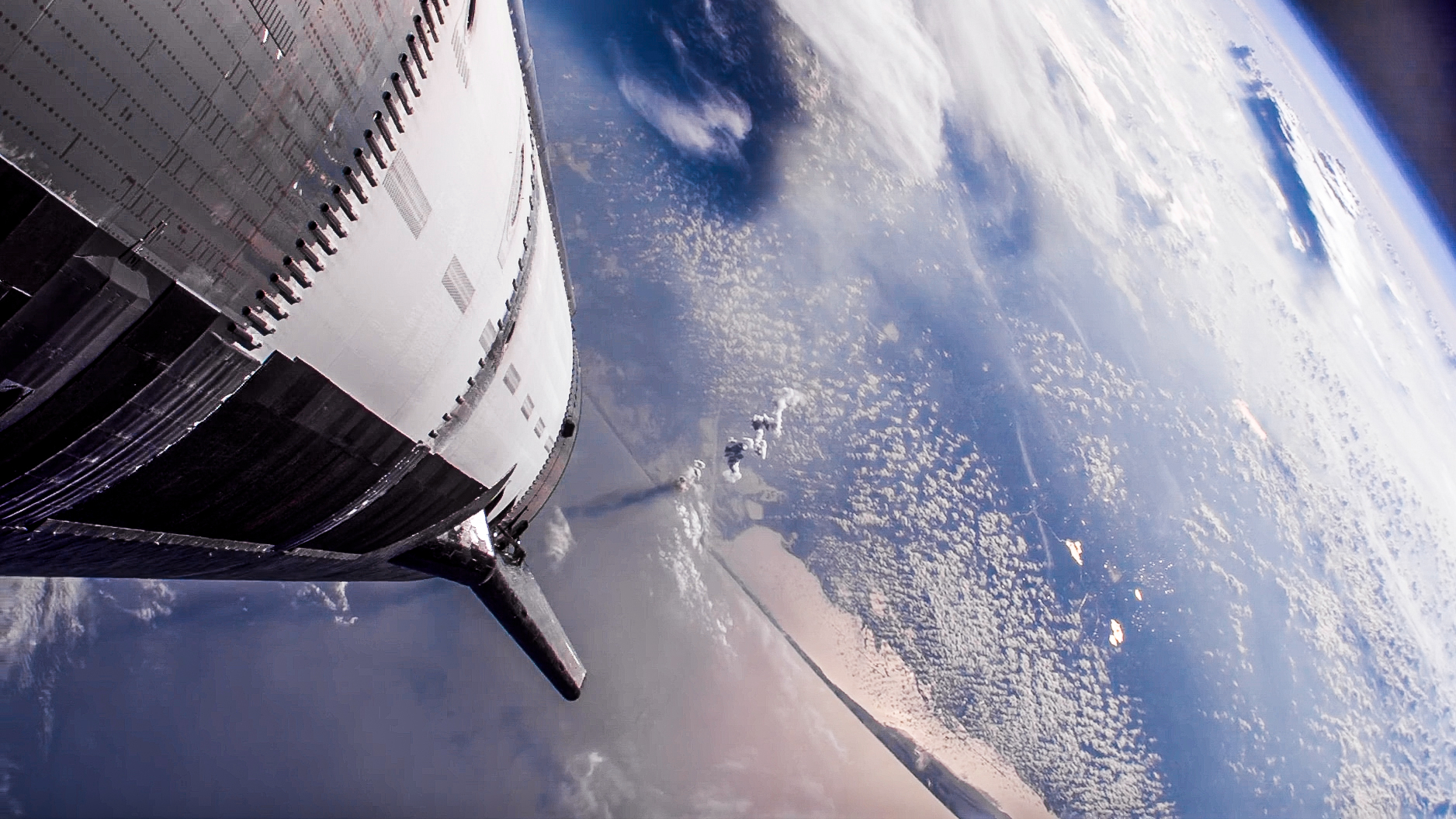A dwarf planet beyond Neptune has a mysterious ring that astronomers can't explain
The ring is so far from the dwarf planet's surface that its material should have coalesced into a moon. But somehow, it didn't.

A mini-planet orbiting in the frigid outer reaches of the solar system has a Saturn-like ring of dust and debris that defies the rules of physics, a new study has revealed.
The planet in question is called Quaoar and it's the seventh largest of the known dwarf planets of which Pluto is the king. Discovered in 2002 and about 697 miles wide (1,121 kilometers), Quaoar is one of the so-called trans-Neptunian objects, small planets orbiting beyond the solar system's outermost planet Neptune.
Residing in the Kuiper Belt, the doughnut-shaped ring of rocky and icy debris in the outer solar system, Quaoar is a proud owner of its own moon, the 100-mile-wide (160 km) Weywot. And a recent observation campaign revealed that it also has a ring of material in its orbit.
That by itself wouldn't be so special. The gas giant Saturn is known to possess a whole series of rings. Jupiter, Neptune and Uranus also have some. One other trans-Neptunian object — Haumea — has been found to have a ring, and the space rock Chariklo that orbits between Saturn and Uranus also has one. So what exactly sets Quaoar's ring apart?
Related: Dwarf planets: science & facts about the solar system’s smaller worlds
Quaoar's ring is at a very unusual distance from its parent body. In fact, before astronomers discovered Quaoar's ring in observations from several telescopes conducted between 2018 and 2021, they had thought that it was impossible for a ring to exist at such a distance. With a radius of about 2,420 miles (3,885 km) from Quaoar's center, the ring is too far away from the dwarf planet that its gravity should no longer be able to keep the material dispersed. Instead, it should coalesce under its own gravity and form another moon, just like Weywot. By not having done that, the ring has breached what astronomers call the Roche limit, the first known ring around a celestial body to have done so.
"What is so intriguing about this discovery around Quaoar is that the ring of material is much farther out than the Roche limit," Giovanni Bruno, an astronomer at Italy's National Institute for Astrophysics (INAF) and one of the authors of the paper, said in a European Space Agency (ESA) statement. "As a result of our observations, the classical notion that dense rings survive only inside the Roche limit of a planetary body must be thoroughly revised."
Get the Space.com Newsletter
Breaking space news, the latest updates on rocket launches, skywatching events and more!
The ring was discovered during a series of occultations, essentially eclipses, when Quaoar passed between Earth and several more distant but much brighter stars. When an occultation occurs, the light of the background star temporarily dims. The effect is only visible to very sensitive telescopes and is frequently used to detect exoplanets orbiting stars in our Milky Way galaxy, which is why ESA's exoplanet hunter Cheops was among the telescopes watching these Quaoar occultations.
When astronomers analyzed the data, they realized that apart from the main dip in the background stars' brightness, they could detect two smaller drops. Since drops occurred before and after the main occultation, respectively, the researchers thought that Quaoar must be surrounded with a ring.
Several Earth-based telescopes also observed the occultations with similar results, but Cheops' data were particularly valuable as they proved that the odd dimmings were not caused by the effects of Earth's atmosphere.
"The Cheops data are amazing for signal to noise," Isabella Pagano, also of INAF and a member of the Cheops Board, said in the statement. "The signal to noise is a measure of how strong the detected signal is to the random noise in the system. Cheops gives a great signal to noise because the telescope is not looking through the distorting effects of Earth’s lower atmosphere."
Now astronomers have to either rethink the Roche limit or come up with another explanation for the existence of Quaoar's ring.
The study was published on Wednesday (Feb. 8) in the journal Nature.
Follow Tereza Pultarova on Twitter @TerezaPultarova. Follow us on Twitter @Spacedotcom and on Facebook.
Join our Space Forums to keep talking space on the latest missions, night sky and more! And if you have a news tip, correction or comment, let us know at: community@space.com.

Tereza is a London-based science and technology journalist, aspiring fiction writer and amateur gymnast. Originally from Prague, the Czech Republic, she spent the first seven years of her career working as a reporter, script-writer and presenter for various TV programmes of the Czech Public Service Television. She later took a career break to pursue further education and added a Master's in Science from the International Space University, France, to her Bachelor's in Journalism and Master's in Cultural Anthropology from Prague's Charles University. She worked as a reporter at the Engineering and Technology magazine, freelanced for a range of publications including Live Science, Space.com, Professional Engineering, Via Satellite and Space News and served as a maternity cover science editor at the European Space Agency.
-
Exo Solaria Union In theory, the ring should have developed at the same time as Quaoar. However, it is possible that the ring used to be a a small Kuiper Belt object and was broken apart by another Kuiper Belt object, and then drifted near Quaoar and then gently settled into orbit around it. Too bad we can't redirect the New Horizons spacecraft to investigate. It would be fascinating to get images of Quaoar and its ring system!Reply -
rod Here is some of my who, what, when, where, how, and why investigations on this subject.Reply
ASTRONOMERS DISCOVER UNEXPECTED RING AROUND DISTANT DWARF PLANET, https://skyandtelescope.org/astronomy-news/astronomers-discover-unexpected-ring-around-distant-dwarf-planet/
"...In Nature, the team reports the presence of a ring 4,100 kilometers from the center of Quaoar, far beyond its classical Roche limit of 1,780 km. Morgado says the ring is dense and irregular. “It has a very thin region about 5 km wide and also a large region about 300 km wide, depending on which part of the ring was probed,” he notes. If the material could all be collected into a single moon, it would be about 10 km in diameter, less than a tenth of Weywot’s size. A few thin, light rings exist beyond the Roche limit elsewhere in the solar system — like the tenuous rings beyond Saturn's F ring — but nothing so massive as the ring around Quaoar. “We were very surprised by the existence of such a ring,” says Morgado. A ring at this distance shouldn’t be stable; it ought to either collapse together or drift apart over time. Though it might have formed after a recent collision in the Quaoar system, that seems unlikely because such a ring should only last a few decades. Other hypotheses Morgado and colleagues pondered include orbital resonances with Quaoar and its moon Weywot, or unusual interactions involving ring particles. In the end, they conclude it might be time to rethink the classical Roche limit."
A reference I see cited, ref - A dense ring of the trans-Neptunian object Quaoar outside its Roche limit, https://www.nature.com/articles/s41586-022-05629-6, 08-Feb-2023.
There are more papers on Quaoar too.
My observation. NASA ADS Abstract, Search for confine material around the TNO (50000) Quaoar, https://ui.adsabs.harvard.edu/abs/2022DPS....5410505M/abstract, December 2022. “The Trans-Neptunian Object (50000) Quaoar, classified as a cubewano, is a dwarf planet candidate with a diameter of 1110 km, a semi-major axis of 43.7 au, and an orbital eccentricity of 0.04. Its satellite Weywot orbits at 13,300 km from the primary object, and its diameter is about 90 km from its flux, assuming the same albedo as Quaoar. It allows the determination of Quaoar's mass of 1.20 x 10^21 kg and bulk density of 2,000 kg.m^-3. Over the years, several campaigns were conducted within the ERC Lucky Star project to observe stellar occultations by Quaoar and Weywot. Besides measuring Quaoar's and Weywot's sizes and shapes, those campaigns aimed at searching for material around this TNO. In this talk, we will present the results of our search for confined material (e.g., rings) around Quaoar based on observations with high photometric accuracy, such as the one observed by the large telescope facility of the Gran Telescopio Canarias (10.4 meters), the CHEOPS space telescope (0.32 meters), and citizen astronomers in Australia and Namibia (between 0.35 and 0.75 meters). The events analysed in this work were observed between 2018 and 2021. Such rings are already known to exist around other small bodies of our Solar System: the Centaur object Chariklo and the dwarf planet Haumea. In particular, these two ring systems, despite significant differences in sizes and heliocentric distances, both orbit close to the 1/3 Spin-Orbit Resonance (SOR) with the central body, meaning that the latter completes three rotations while a ring particle completes one orbital revolution. That makes the 1/3 SOR location an interesting region for searching for such rings. In particular, considering Quaoar's rotation period of 17.6788 hours, that will put the 1/3 SOR at about 4,200 km (7.5 Quaoar radii) away from Quaoar's center, and this would be well outside the Roche limit of the central body of 1.780 km (3.2 Quaoar radii), assuming that the bulk density of particles would be around 400 kg.m-3 (typical of Saturnian small satellites). This will be discussed in detail during the presentation. Acknowledgments. The work leading to these results has received funding from the European Research Council under the European Community's H2020 2014-2021 ERC Grant Agreement no. 669416 "Lucky Star".
My note. Using 1.2 x 10^21 kg = 1.2 x 10^24 g, a=43.7 au, e=0.04, I calculate P = 2.8890E+02 years or 288.9 years. In 1 Gyr, 3.4614E+06 revolutions around the Sun. How long can the ring system be maintained? Is the ring system evidence for a much younger ring age? -
Becky I'm new here, but I had to comment.Reply
The Astrophysicist is Giovanni Bonanno. Giovanni Bruno was a 17th century astronomer and philosopher. I do think the article, since it is running in some fairly reputable company (ESA and INAF), needs to be corrected.
Thanks. -
chicmac Just a passing thought, if the particles are small and if there is sufficient gravitational filtering of the protons and electrons released by solar events at that distance then perhaps the particles could be negatively charged? Or perhaps it is just a recent formation.Reply
